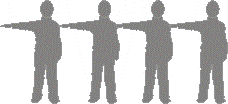
LINING UP

|
|
LINING UP |
|
By lining up correctly, the class reminds themselves that they are studying a martial art and shows their consideration for others. Students should always line up formally whether it is a permanent or temporary dojo (training hall), because it gives a serious feel to the practice session, helping everyone get into the proper mood. Lining up properly is particularly important for special events such as demonstrations, testing, promotions, and high-ranking instructor visits.
Not all martial arts classes line up the same way. Traditional schools often follow strict standards; sport, seminar, and short-term classes usually follow very few. It is up to the instructor to choose which blueprint the class follows based on safety and practical issues (size of the room, noise, doors, etc.). Rules should not be based on whim; each should be backed by a purpose. For instance, placing beginning students behind advanced students allows the beginners to copy the advanced students without feeling watched by them.
Students lining up for the first few times shouldnít worry about the details. Senior students will help them line up when they donít know where to go. Always keep a safe distance from other people, walls, mirrors, railings, etc., and everything else will work itself out. Safety is always the instructorís first concern.
To line up correctly people have to know the parts of the dojo, the class rank structure, distancing, and how things change in special cases. The shomen (front section) is the front part of the dojo. Placing flags, school crests, mirrors, and slogans/ideals in the shomen is a widespread practice. The shomen is the direction everyone bows toward when entering or leaving the dojo and is the place the class faces. It is also the area reserved for instructors and guests. If uniforms become undone or belts need to be retied during class, students should face away from the shomen when adjusting them.
The shinzen (place of honor) is in the center of the shomen and is where a kamiza (shrine), a photograph of the founder of the martial art being practiced (Jigoro Kano for Judo, Morihei Ueshiba for Aikido, etc.), and motivational calligraphy can be displayed. Facing the shomen, the joseki (high seat) of the instructor line is located to the far right. It is set aside for the highest-ranking teacher or guest instructors.
The shimoza (back section) is the student area. If no other area is available, shoes and gym bags are placed against the back wall neatly. Bulletin boards with class news are occasionally located here. When facing the shomen, the shimoseki (low seat) of the student line is to the far left.
When lining up, instructors face the class between the students and the shomen. Instructors line up in rank order with the most senior in the joseki position. When a guest instructor is present, they are offered the joseki spot, followed by the customary instructor(s).
Students line up facing the shomen with the Dai sempai (senior student) to the far right. The senior student begins the first line far enough away from the instructors to allow them room; then the other students fall in line to the left of the senior student. When a line gets close to a wall, the remaining students begin a new line in back of the previous line and directly behind the senior student.
The line order for ranked students is determined by the rank structure and seniority within each grade. For example, a yonkyu (fourth class - green belt) promoted a year ago is higher than a yonkyu promoted last month; both yonkyu are lower than a sankyu (third class - brown belt) promoted today. Facing the shomen, the order for a row made up of these people would begin with the brown belt to the right, followed by the green belt promoted a year ago to the brown beltís left, and end with the green belt promoted last month.
For unranked students, the order is determined by starting date and age. A white belt who started three months ago is higher than one who started two months ago. When two white belts start on the same day last week, the older student is higher; i.e., a 15-year old is higher than a 12-year old. Facing the shomen, the order for a row made up of these people would start with the white belt who started three months ago on the right, followed by the white belt who started two months ago, the 15-year old white belt, and finish with the 12-year old white belt at the far left.
Spacing within a row should be one armís length when little motion is needed (kneeling, sitting, bowing in), two armsí lengths when practicing (kicking, stretching, kata), and three or more when necessary (sparring, weapons, groundwork). The gap between rows should be equal to the body lengths (about a push-up position) of the people in front, with added space for instructors and assistants to move between. It is important to line up in a straight line relative to the person on the end to avoid accidents. If the row is just a little off it will be diagonal, and someone will be too close to other students or limit instructor movement.
People without uniforms should be to the left of students with complete uniforms. Sometimes ranked students donít have part of their uniforms and will frequently watch class. If the instructor allows them in class, they take spots at the end of the line. Higher ranks are held to higher standards: instructors without a complete uniform are not allowed in class, brown belts might be seen once in a great while, and unranked students with incomplete uniforms are fine most of the time.
In the early part of a class, it is possible to have a brown belt at the far left, behind a white belt, behind a green belt, and all of them behind someone without a uniform because being late affects the usual line up order. Someone coming in late canít expect to take their proper position in line and make other people adjust for their tardiness. To avoid disturbing class, late arrivals should wait on the side for the instructor to bow them into class (and might be required to complete some warm-up exercises or meditate) before joining the class at the end of the line. When people adjust their lines to break into smaller groups or to end class, the late arrivals return to their regular positions.
One of the few times a line should adjust for someone is when they are being promoted. When a person is called up for promotion by the instructor, the other students in the current rank should move left to make a place at the end of the new rank. After promotion, the newly-promoted student returns to the line in the new location.
Even though they often follow the regular order, instructors are free to use unusual arrangements during a class. They can assign senior students to work with newcomers. They might also turn some lines around so that the higher-ranked students can act as mirrors for the lower ranks. In addition, they may position students who perform techniques well next to people who donít or separate people who disturb each other.
ó { Ė